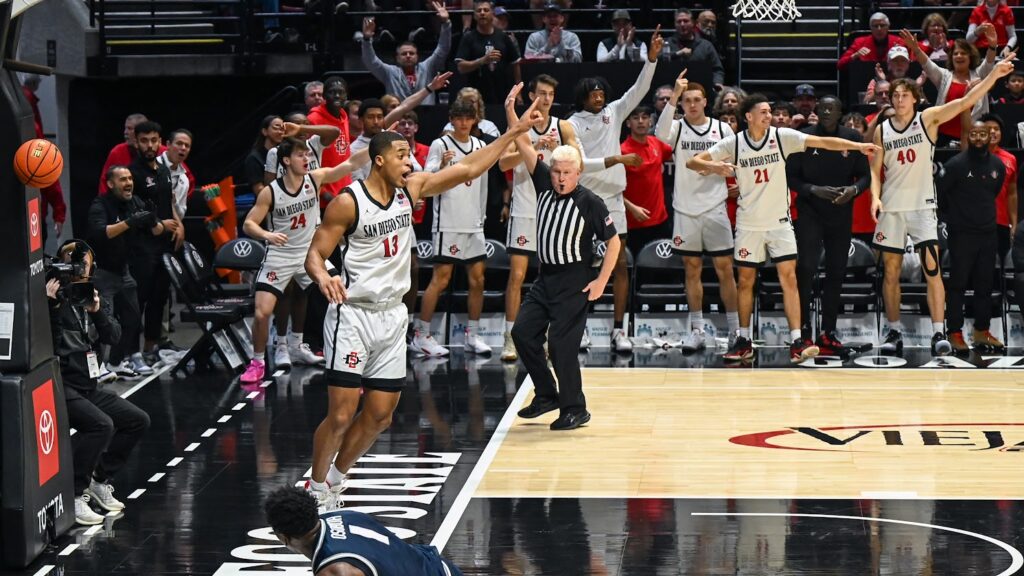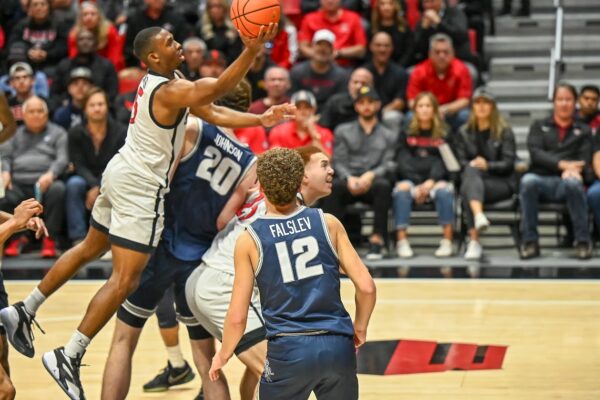San Diego State Aztecs vs Air Force Falcons Basketball Preview

SDSU gives aid to the refs. (Deanna Goldberg/EVT)

The San Diego State Aztecs start a road trip by traveling to Colorado Springs to face the Air Force Falcons. After a change to the starting lineup, the Aztecs beat the Utah State Aggies 81-67 in their last game. SDSU will be looking to keep up the momentum and build a winning streak, something that has eluded them the last few weeks.
The Falcons are on a three game losing streak after losing to the Boise State Broncos on the road by a score of 94-56. They are 1-8 in conference this season, and there does not seem to be much hope of things improving.
General Observations
Air Force is a small team; no player stands taller than 6-foot-7. The Falcons play very patiently on offense, passing up good looks for even better ones. They are hyper-efficient scorers but well below average in terms of rebounding, turnovers, and drawing fouls.
How to guard Air Force
Air Force plays a Princeton-style offense. The Princeton is characterized by a few key features.
One is constant ball and player movement. Players stay mobile and swing the ball around more than is usual for other teams.
Another feature is the read-and-react nature of the offense. For many teams, plays have a set nature, and while there may be a counter or two present within the play, most of it is set in stone to get a desired outcome. In the Princeton, players generally have more autonomy.
Players are not only allowed but they are expected to break from the original play design based on how the defense is playing. The most common example, if a defender is playing ball denial, the offensive player is expected to cut behind them toward the basket.
Air Force with one of their famous back cuts. pic.twitter.com/2cqIMTOf7M
— Aztec Breakdown (@aztecbreakdown) February 5, 2024
Lastly, the Princeton offense usually creates equity in terms of shot attempts. It’s a system built off of team play rather than playing through a star. Disrupting the offense can be difficult because if it is taught well, there is a built-in counter for every possible defense an opponent can throw at it.
The first key will be ball pressure. If players like Lamont Butler, Darrion Trammell, and Miles Byrd can hound their man on the perimeter, it can cause turnovers and make passes to open cutters difficult to complete. The Falcons tend to commit more turnovers than an average team, so extending the defense to force miscues is important.
At elevation, a full-court press will be difficult, but harassing dribblers and playing ball denial to make passes tough should be the goal. Air Force will still get some easy layups on back cuts, but teams cannot stop everything defensively.
The Falcons are one of the best shooting teams in the nation, regardless of where they are on the floor. Contesting and preventing shots will be crucial.
The final key is controlling the glass. The Aztecs cannot allow the Falcons to take shot after shot until they make one. Air Force does not have a player taller than 6-foot-7, and they have struggled on the offensive glass all season. If SDSU slacks on rebounding, Air Force will take advantage of it. They are unlikely to miss two or three shots in a row.
How to attack Air Force
As opposed to playing a Man-to-Man, or a 2-3 Zone, or some other well-known style of defense, Air Force plays a matchup zone defense. Matchup zones are hard to define because they can be a number of different things and can look a lot of different ways.
At the most basic level, a matchup zone has the defender who is guarding the ball handler playing a tight man-to-man style defense, while the off ball players play in a designated zone alignment. Players’ roles will change as the ball changes hands.
The type of zone can vary from game to game, play to play, or for really good teams within the same play. Over the course of the season, the Falcons have shown zones similar to a box-and-1, 2-3, and 1-3-1 zone.
That fluidity is what can make the zone hard to attack, because it is hard for offensive players in real time to know what set they are supposed to call. The good news for the Aztecs is they have the personnel to beat Air Force without getting too complicated.
Jaedon LeDee specifically is ideally suited to beat Air Force. To start, LeDee is a zone buster. He is extremely efficient at shooting from the free throw line, which is a weak spot for most zone defenses. He can also attack closeouts from that spot. If the Aztecs can get him the ball there, he can do some damage.
Air Force also likes to front post players. The defenders stay in between the player and the ball rather than the player and the rim. The intent is to make entry passes difficult. LeDee is taller than anyone on the Falcons’ roster, though, so throwing balls over the defender where only he can get them should be an option.
Using high-low passes should work against Air Force. pic.twitter.com/oAGcxqkYkI
— Aztec Breakdown (@aztecbreakdown) February 5, 2024
In addition, Air Force has shown it will switch defenders on screens within its zone coverage. Which means it should be possible to get LeDee matched up against a guard before getting him the ball.
Osobor gets a switch against Air Force pic.twitter.com/1qTDMUzpAr
— Aztec Breakdown (@aztecbreakdown) February 5, 2024
Earlier this season, JT Toppin scored 25 points against Air Force. Great Osobor scored 32. LeDee has not scored 20 points in four straight contests, his longest stretch of the season. LeDee should be able to get at least 20 this game.
The other impact of getting LeDee the ball is that he draws so much attention, other players should be able to sneak in for offensive rebounds. Guys like Jay Pal and Elijah Saunders should be aggressive on the offensive glass and rack up second-chance points.
Plays to watch for
Chin offense
Like many other sets, Chin has multiple variations based off the way defenses match up against it. The main aspect involves a pass from the top of the key to the wing. The passer then cuts off a back screen toward the hoop. Meanwhile, the wing player passes to the strong side corner, and cuts off of a flare screen, with the option to either curl to the basket, or flare for a three point attempt, depending on how the defense has reacted.
Expect to see many variations of this play during the game.
Air Force running “chin” pic.twitter.com/t1odlJl059
— Aztec Breakdown (@aztecbreakdown) February 5, 2024
Low post series
Like everything else Air Force does, their low post series can be hard to identify because they have multiple ways of entering into it, multiple finishes out of it, and multiple counters that look alike but then change at the last minute.
The first action to look for any time the ball enters the low post is for the strong side wing player to curl off a screen toward the basket, looking to receive a pass.
One option out of Air Force’s low post series. pic.twitter.com/VMk9aYF4aD
— Aztec Breakdown (@aztecbreakdown) February 5, 2024
This can happen off of a traditional entry pass or if the ball handler simply dribbles to the low block.
Low post series pt 2. pic.twitter.com/OdNfL7NdEs
— Aztec Breakdown (@aztecbreakdown) February 5, 2024
There are too many variations to describe them all in detail, but basket cuts and low post passing is a core principle they use.
Players to watch
Rytis Petraitis, #31, 15.6 points, 5.6 rebounds, 3.9 assists
Rytis Petraitis started the season injured but has come on strong since he returned to the lineup. He is efficient at scoring from most anywhere on the floor, draws contact often, and makes his teammates better. Slowing him down is the top priority for any opponent.
Ethan Taylor, #5, 15.7 points, 4.5 rebounds, 2.8 assists
Ethan Taylor rarely comes off the floor. His size at 6-foot-5 can cause problems for opposing guards, and he can stretch defenses with his shooting ability. Despite being a force offensively, his defense is below average, according to most metrics.
Beau Becker, #14, 15.1 points, 4.7 rebounds, 1.7 assists
Becker is the best shooter among a stable of shooters for the Falcons. He has shot 42.3% on 123 attempts this season. He is an ideal Princeton offense player as he has good size, makes good decisions, and can hit shots whether he is stationary, moving, or coming off of screens.
X-Factor
Controlling the glass.
The Aztecs are bigger, stronger, and more athletic than the Falcons. Air Force does not put a high priority on offensive rebounding, and playing largely in a zone defense makes defensive rebounding hard as well. Both physically as well as schematically, the Aztecs should have an advantage on the glass. If they press it, they should come out on top.
Native San Diegan living in Montana. Big time Aztec Basketball fan. Creator of Aztec Breakdown. Hoping to help people enjoy basketball more by increasing their understanding of it.